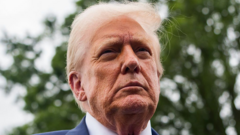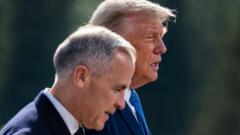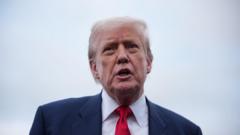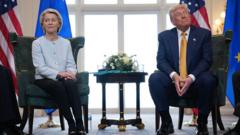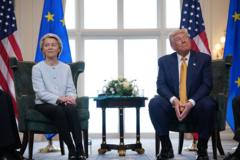Despite a temporary pause in tariffs, both nations face long-standing trade imbalances and geopolitical issues that complicate the path forward.
China Takes a Step Toward Trade Resolution, but Tensions Linger

China Takes a Step Toward Trade Resolution, but Tensions Linger
The latest negotiations between the US and China provide a glimmer of hope amidst ongoing tariffs, yet significant challenges remain.
In a surprising shift, recent talks between the United States and China have raised optimism about de-escalating the trade war that has increasingly strained economic relations. As negotiators gathered in Switzerland, both sides demonstrated a willingness to engage in discussions that could lead to tariff relief—a notable departure from their historically defiant postures.
US Treasury Secretary Scott Bessent expressed a shared interest in avoiding economic decoupling, indicating that neither nation desires a breakdown in trade relations. “The consensus from both delegations is neither side wants a decoupling," he noted during a press conference following the talks. This sentiment was echoed by economists who remarked that the agreed-upon reductions in US tariffs on Chinese imports to 30% and Chinese tariffs on US goods to 10% were more favorable than anticipated.
President Trump hailed the engagement on his social media platform and framed it as a constructive negotiation, while Beijing softened its tone significantly, suggesting a willingness to collaborate amidst dire economic conditions. The Chinese economy is grappling with a range of issues, including high youth unemployment, faltering factory output, and a declining consumer price index that reflects a dip in consumer spending.
The Chinese Commerce Ministry hailed the agreement as a vital step towards resolving differences, establishing a foundation for future negotiations. While optimistic rhetoric emerged from both sides, China’s statement emphasized a mutual effort for progress, warning against unilateral tariff increases and expressing the limits of patience in response to perceived US provocations.
Despite the temporary reprieve in tariffs that allows for negotiations over the coming 90 days, experts emphasize that fundamental issues, such as the significant trade imbalance and contentious geopolitical concerns in areas like Taiwan, remain unresolved. The underlying struggle for a more equitable trade relationship is far from concluded; it simply has transitioned to a new focus on dialogues in both Beijing and Washington.
As both countries endeavor to address their substantial differences, it remains clear that the road ahead is complex and fraught with challenges that require continued dialogue and diplomacy. The recent developments may suggest a shift in tone, but analysts caution that deeper, systemic issues are still at play, underscoring that the fight over trade is far from over.
US Treasury Secretary Scott Bessent expressed a shared interest in avoiding economic decoupling, indicating that neither nation desires a breakdown in trade relations. “The consensus from both delegations is neither side wants a decoupling," he noted during a press conference following the talks. This sentiment was echoed by economists who remarked that the agreed-upon reductions in US tariffs on Chinese imports to 30% and Chinese tariffs on US goods to 10% were more favorable than anticipated.
President Trump hailed the engagement on his social media platform and framed it as a constructive negotiation, while Beijing softened its tone significantly, suggesting a willingness to collaborate amidst dire economic conditions. The Chinese economy is grappling with a range of issues, including high youth unemployment, faltering factory output, and a declining consumer price index that reflects a dip in consumer spending.
The Chinese Commerce Ministry hailed the agreement as a vital step towards resolving differences, establishing a foundation for future negotiations. While optimistic rhetoric emerged from both sides, China’s statement emphasized a mutual effort for progress, warning against unilateral tariff increases and expressing the limits of patience in response to perceived US provocations.
Despite the temporary reprieve in tariffs that allows for negotiations over the coming 90 days, experts emphasize that fundamental issues, such as the significant trade imbalance and contentious geopolitical concerns in areas like Taiwan, remain unresolved. The underlying struggle for a more equitable trade relationship is far from concluded; it simply has transitioned to a new focus on dialogues in both Beijing and Washington.
As both countries endeavor to address their substantial differences, it remains clear that the road ahead is complex and fraught with challenges that require continued dialogue and diplomacy. The recent developments may suggest a shift in tone, but analysts caution that deeper, systemic issues are still at play, underscoring that the fight over trade is far from over.



